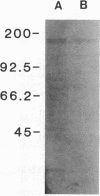Abstract
Establishment of adherence by Entamoeba histolytica is mediated by a 170-kD Gal/GalNAc inhibitable lectin and is required for cytolysis and phagocytosis of mammalian target cells. We studied the biochemical mechanisms of the in vitro interaction between rat and human colonic mucins and axenic E. histolytica trophozoites. Crude mucus prevented amebic adherence to Chinese hamster ovary (CHO) cells by up to 70%. Purification of the colonic mucins by Sepharose 4B chromatography, nuclease digestion, and cesium chloride gradient centrifugation resulted in a 1,000-fold enrichment of the inhibitory mucins. Purified rat mucin inhibited amebic adherence to and cytolysis of homologous rat colonic epithelial cells. Oxidation and enzymatic cleavage of rat mucin Gal and GalNAc residues completely abrogated mucin inhibition of amebic adherence. The binding of rat 125I-mucin to amebae was galactose specific, saturable, reversible, and pH dependent. A monoclonal antibody specific for the 170-kD amebic Gal/GalNAc lectin completely inhibited the binding of rat 125I-mucin. Rat mucin bound to Affigel affinity purified the amebic lectin from conditioned medium. Colonic mucin glycoproteins act as an important host defense by binding to the parasite's adherence lectin, thus preventing amebic attachment to and cytolysis of host epithelial cells.
Full text
PDF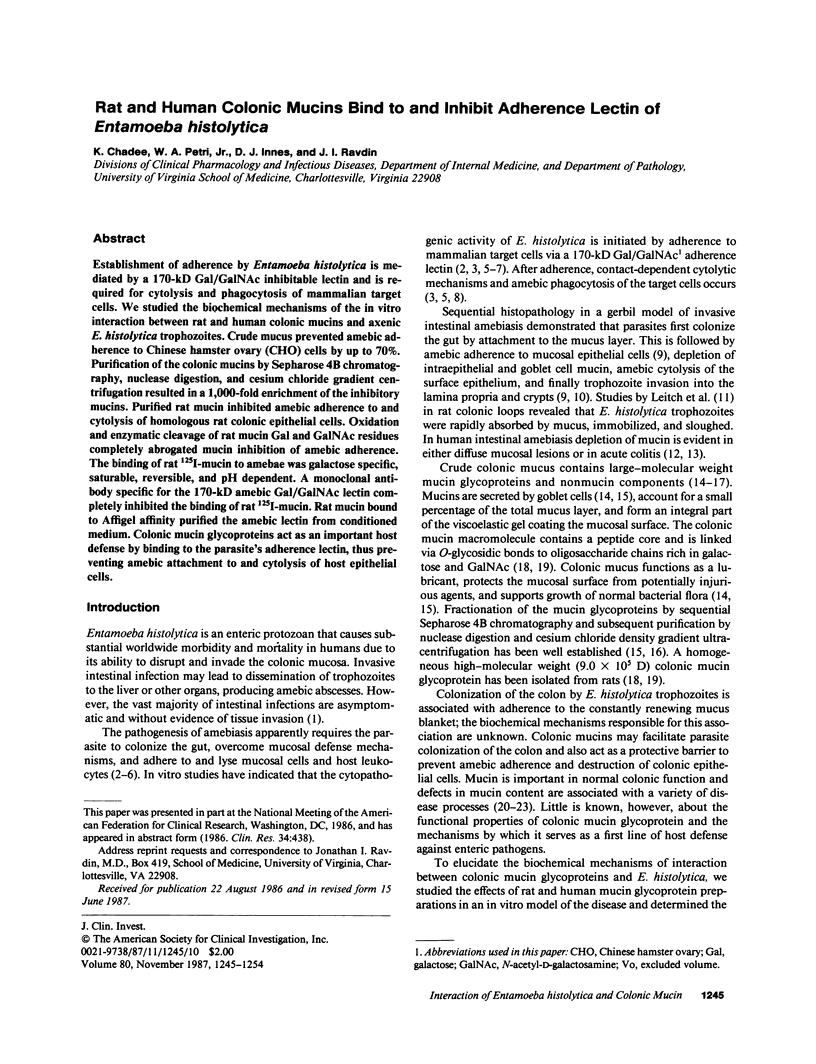
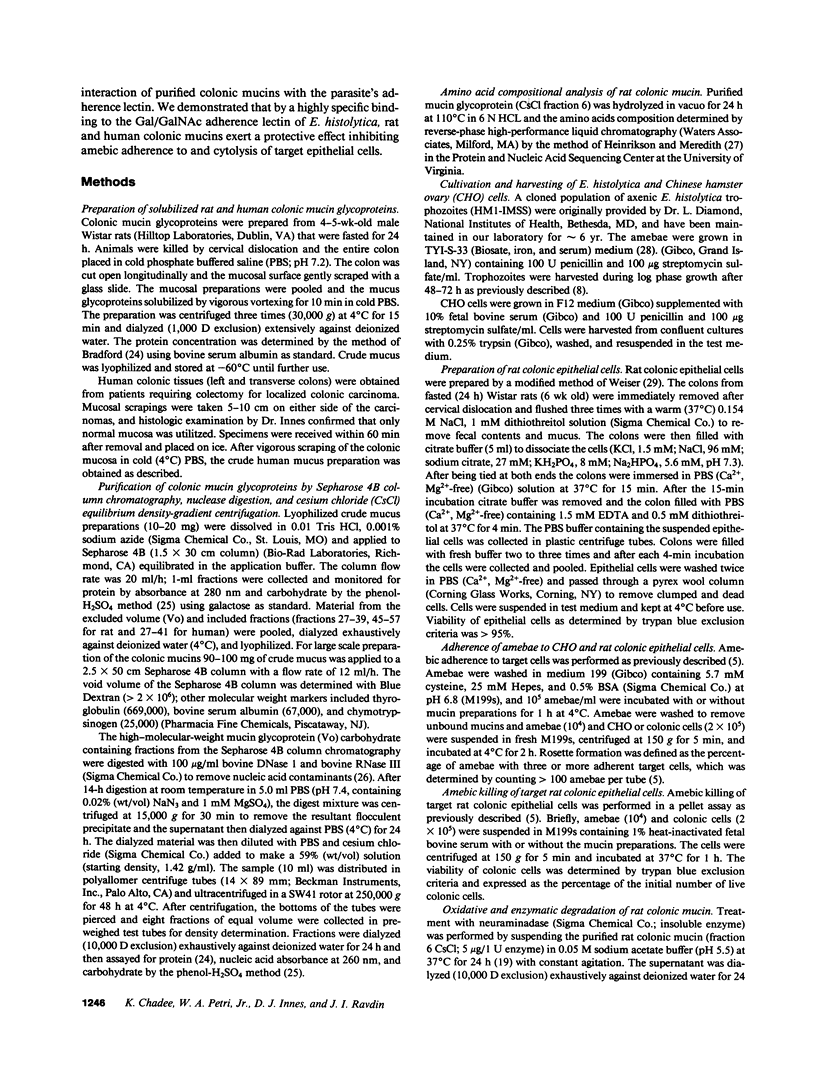
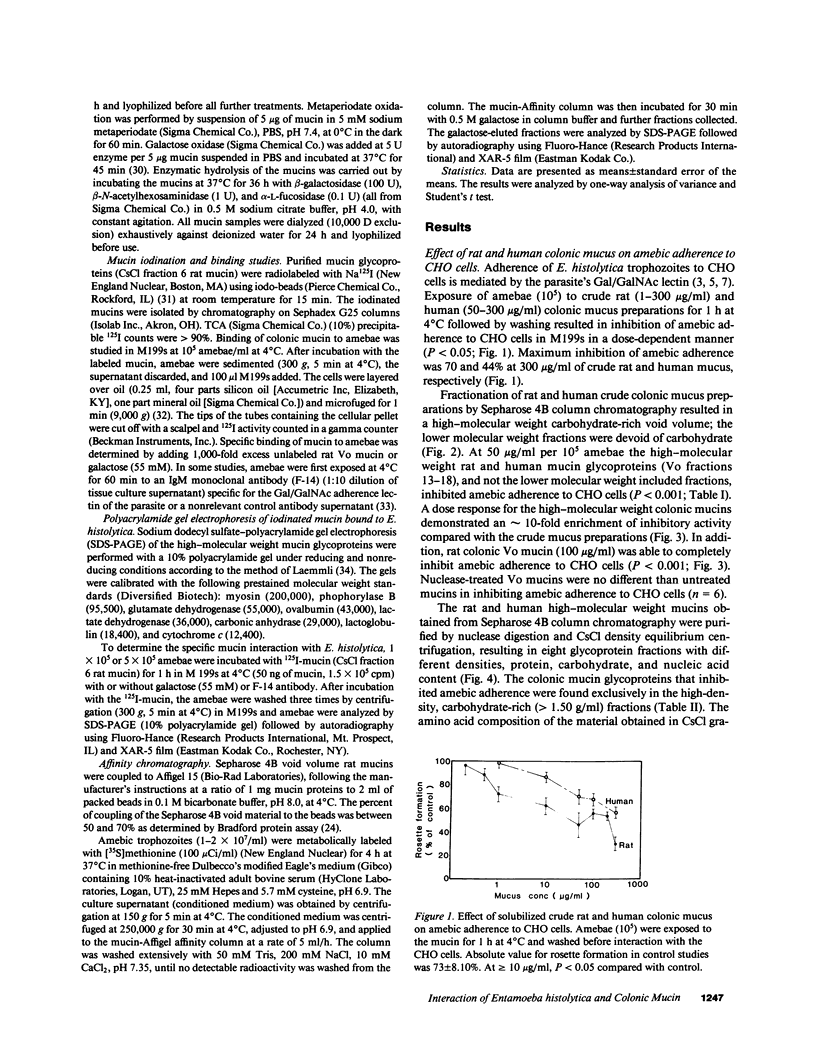
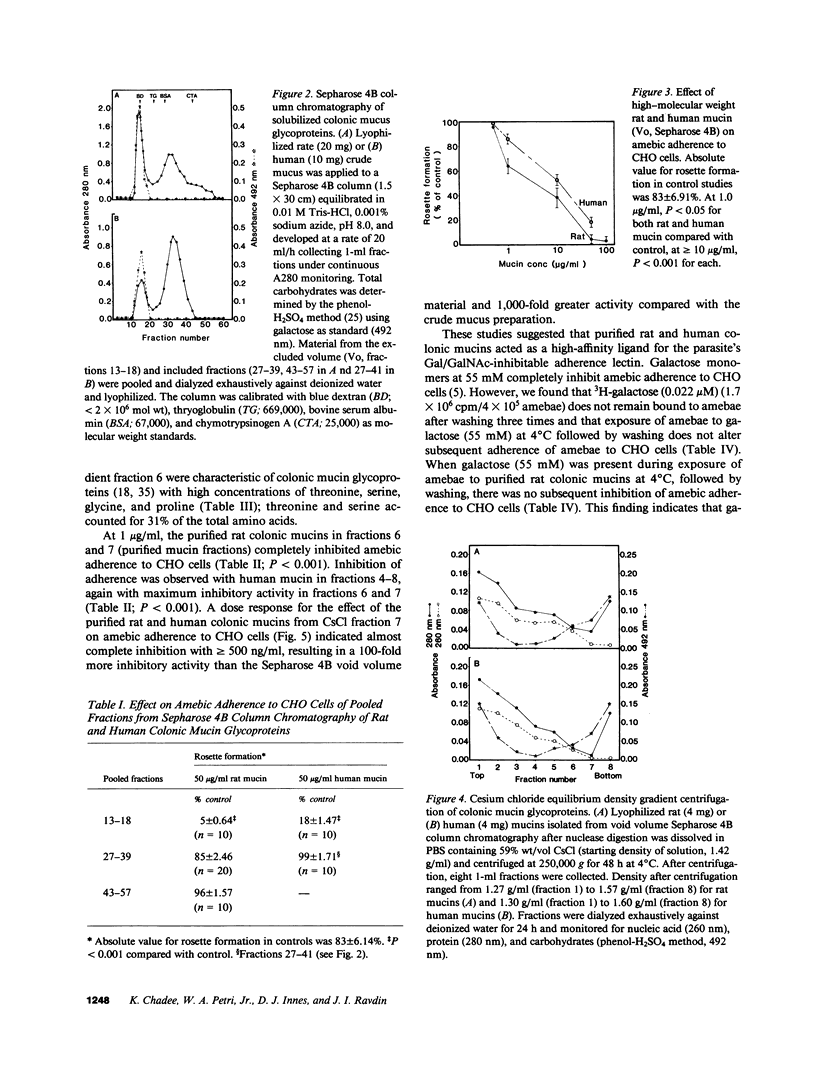
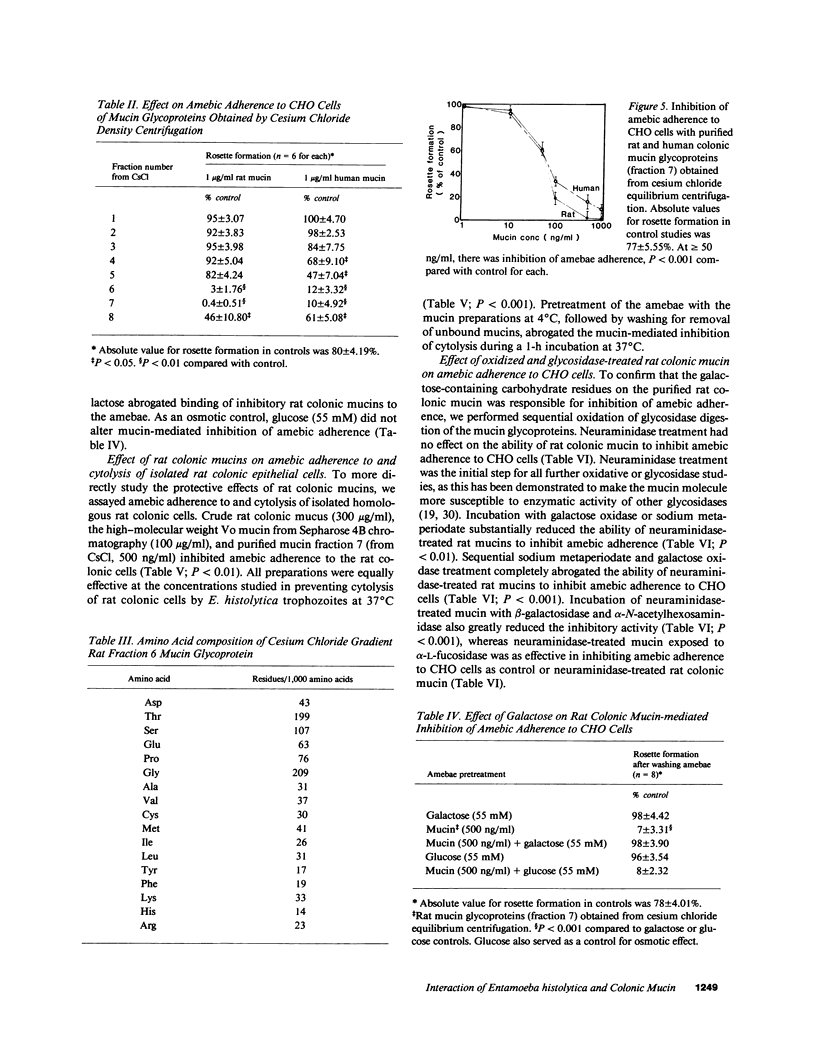
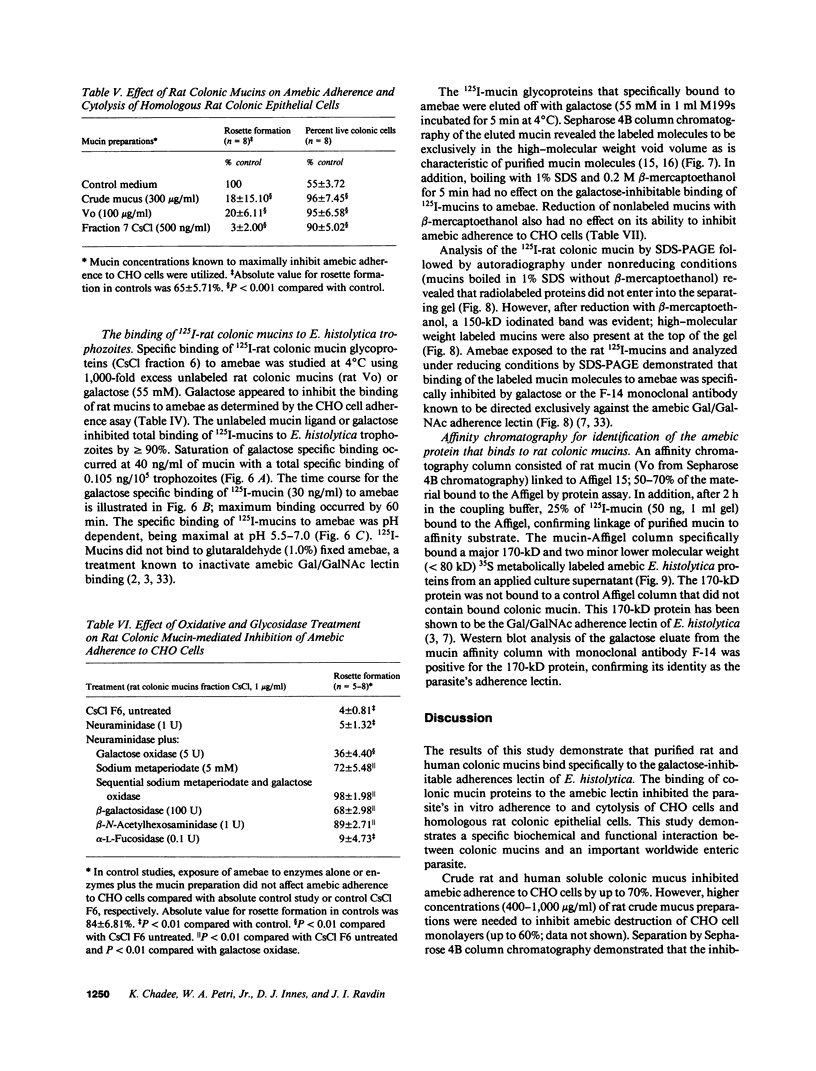
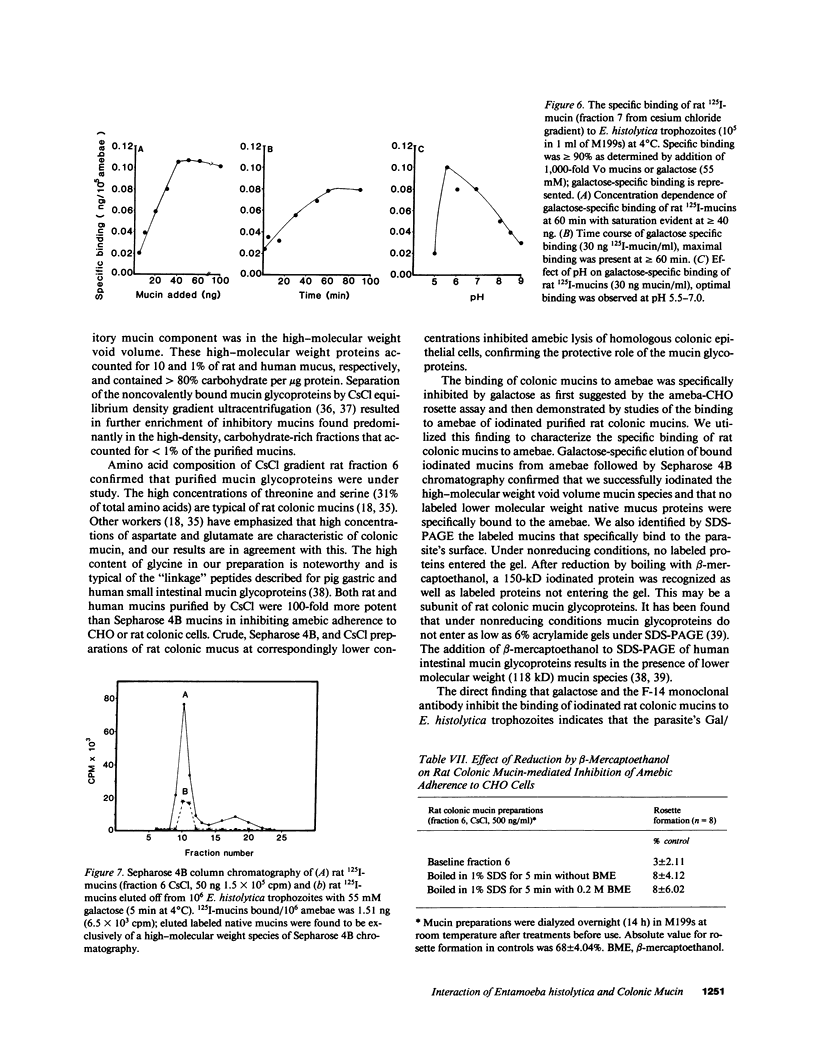
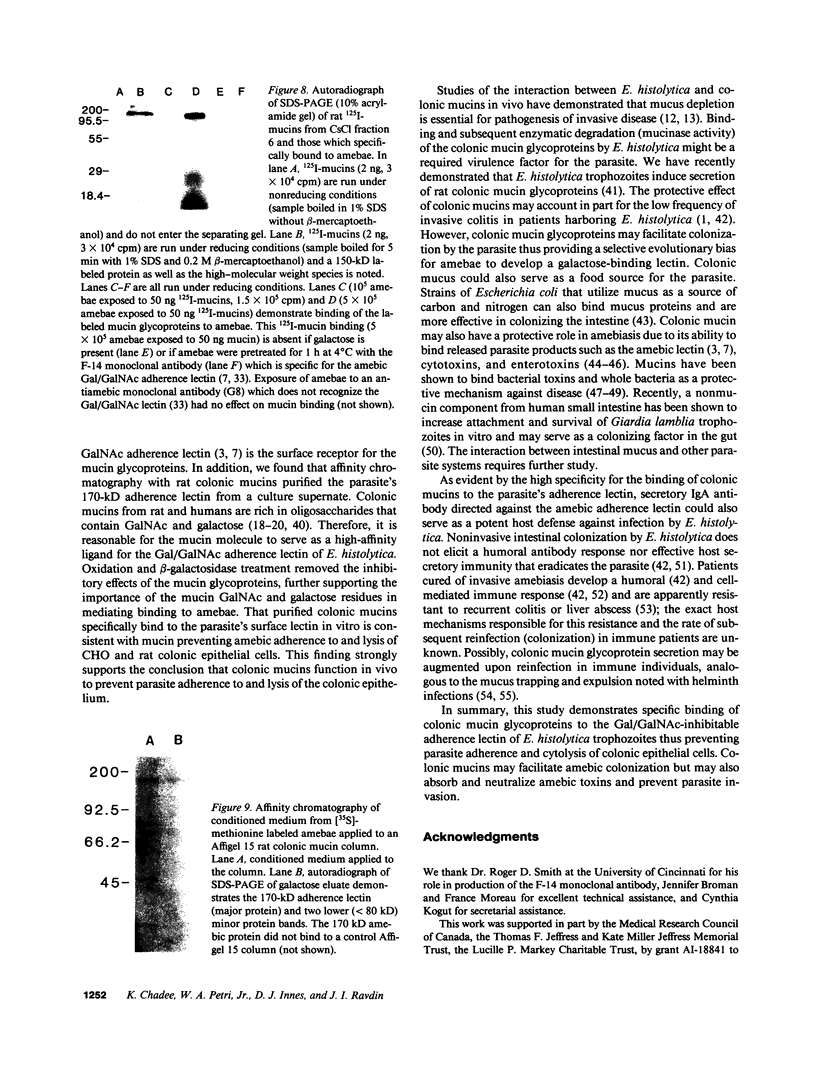
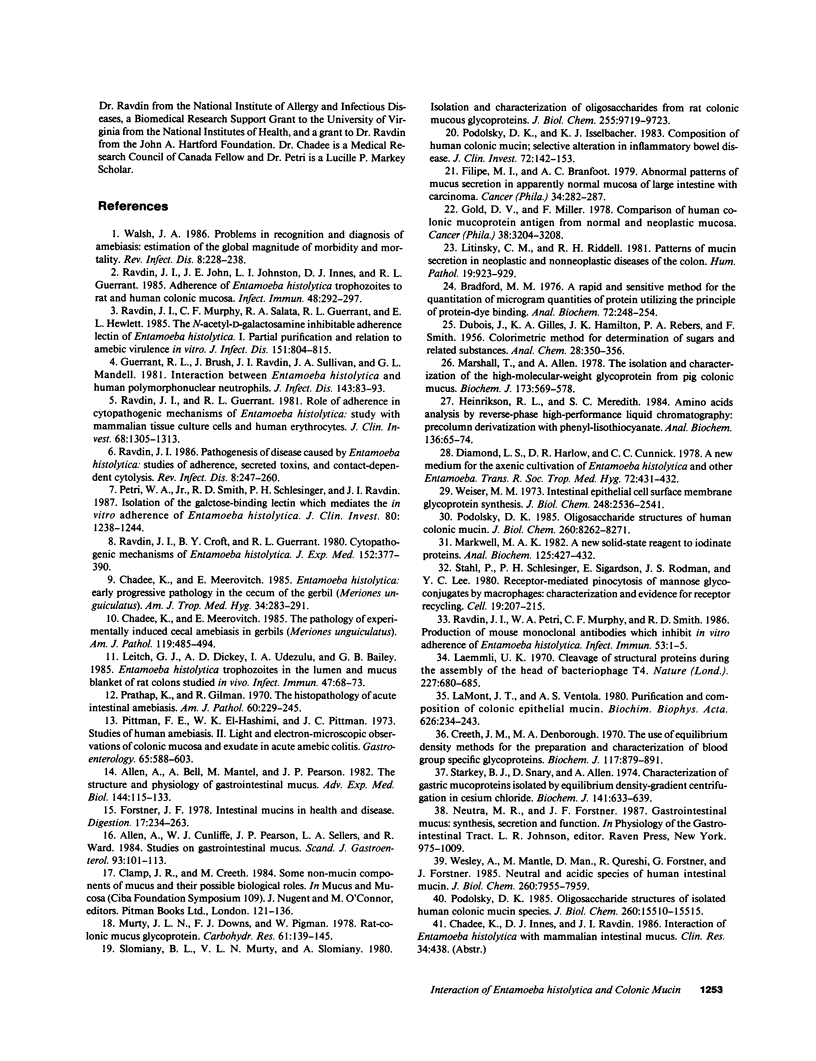
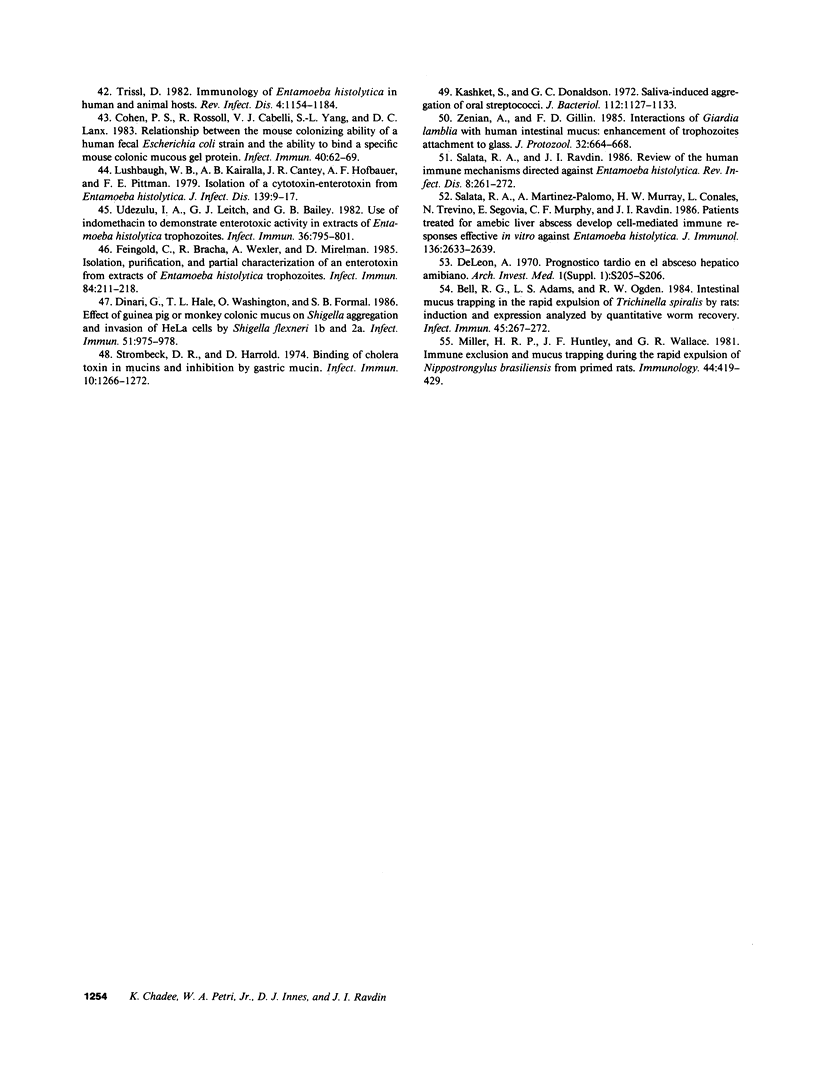
Images in this article
Selected References
These references are in PubMed. This may not be the complete list of references from this article.
- Allen A., Bell A., Mantle M., Pearson J. P. The structure and physiology of gastrointestinal mucus. Adv Exp Med Biol. 1982;144:115–133. doi: 10.1007/978-1-4615-9254-9_15. [DOI] [PubMed] [Google Scholar]
- Allen A., Cunliffe W. J., Pearson J. P., Sellers L. A., Ward R. Studies on gastrointestinal mucus. Scand J Gastroenterol Suppl. 1984;93:101–113. [PubMed] [Google Scholar]
- Bell R. G., Adams L. S., Ogden R. W. Intestinal mucus trapping in the rapid expulsion of Trichinella spiralis by rats: induction and expression analyzed by quantitative worm recovery. Infect Immun. 1984 Jul;45(1):267–272. doi: 10.1128/iai.45.1.267-272.1984. [DOI] [PMC free article] [PubMed] [Google Scholar]
- Bradford M. M. A rapid and sensitive method for the quantitation of microgram quantities of protein utilizing the principle of protein-dye binding. Anal Biochem. 1976 May 7;72:248–254. doi: 10.1016/0003-2697(76)90527-3. [DOI] [PubMed] [Google Scholar]
- Chadee K., Meerovitch E. Entamoeba histolytica: early progressive pathology in the cecum of the gerbil (Meriones unguiculatus). Am J Trop Med Hyg. 1985 Mar;34(2):283–291. doi: 10.4269/ajtmh.1985.34.283. [DOI] [PubMed] [Google Scholar]
- Chadee K., Meerovitch E. The pathology of experimentally induced cecal amebiasis in gerbils (Meriones unguiculatus). Liver changes and amebic liver abscess formation. Am J Pathol. 1985 Jun;119(3):485–494. [PMC free article] [PubMed] [Google Scholar]
- Clamp J. R., Creeth J. M. Some non-mucin components of mucus and their possible biological roles. Ciba Found Symp. 1984;109:121–136. doi: 10.1002/9780470720905.ch9. [DOI] [PubMed] [Google Scholar]
- Cohen P. S., Rossoll R., Cabelli V. J., Yang S. L., Laux D. C. Relationship between the mouse colonizing ability of a human fecal Escherichia coli strain and its ability to bind a specific mouse colonic mucous gel protein. Infect Immun. 1983 Apr;40(1):62–69. doi: 10.1128/iai.40.1.62-69.1983. [DOI] [PMC free article] [PubMed] [Google Scholar]
- Creeth J. M., Denborough M. A. The use of equilibrium-density-gradient methods for the preparation and characterization of blood-group-specific glycoproteins. Biochem J. 1970 May;117(5):879–891. doi: 10.1042/bj1170879. [DOI] [PMC free article] [PubMed] [Google Scholar]
- Diamond L. S., Harlow D. R., Cunnick C. C. A new medium for the axenic cultivation of Entamoeba histolytica and other Entamoeba. Trans R Soc Trop Med Hyg. 1978;72(4):431–432. doi: 10.1016/0035-9203(78)90144-x. [DOI] [PubMed] [Google Scholar]
- Dinari G., Hale T. L., Washington O., Formal S. B. Effect of guinea pig or monkey colonic mucus on Shigella aggregation and invasion of HeLa cells by Shigella flexneri 1b and 2a. Infect Immun. 1986 Mar;51(3):975–978. doi: 10.1128/iai.51.3.975-978.1986. [DOI] [PMC free article] [PubMed] [Google Scholar]
- Feingold C., Bracha R., Wexler A., Mirelman D. Isolation, purification, and partial characterization of an enterotoxin from extracts of Entamoeba histolytica trophozoites. Infect Immun. 1985 Apr;48(1):211–218. doi: 10.1128/iai.48.1.211-218.1985. [DOI] [PMC free article] [PubMed] [Google Scholar]
- Filipe M. I., Branfoot A. C. Abnormal patterns of mucus secretion in apparently normal mucosa of large intestine with carcinoma. Cancer. 1974 Aug;34(2):282–290. doi: 10.1002/1097-0142(197408)34:2<282::aid-cncr2820340211>3.0.co;2-w. [DOI] [PubMed] [Google Scholar]
- Forstner J. F. Intestinal mucins in health and disease. Digestion. 1978;17(3):234–263. doi: 10.1159/000198115. [DOI] [PubMed] [Google Scholar]
- Gold D. V., Miller F. Comparison of human colonic mucoprotein antigen from normal and neoplastic mucosa. Cancer Res. 1978 Oct;38(10):3204–3211. [PubMed] [Google Scholar]
- Guerrant R. L., Brush J., Ravdin J. I., Sullivan J. A., Mandell G. L. Interaction between Entamoeba histolytica and human polymorphonuclear neutrophils. J Infect Dis. 1981 Jan;143(1):83–93. doi: 10.1093/infdis/143.1.83. [DOI] [PubMed] [Google Scholar]
- Heinrikson R. L., Meredith S. C. Amino acid analysis by reverse-phase high-performance liquid chromatography: precolumn derivatization with phenylisothiocyanate. Anal Biochem. 1984 Jan;136(1):65–74. doi: 10.1016/0003-2697(84)90307-5. [DOI] [PubMed] [Google Scholar]
- Kashket S., Donaldson C. G. Saliva-induced aggregation of oral streptococci. J Bacteriol. 1972 Dec;112(3):1127–1133. doi: 10.1128/jb.112.3.1127-1133.1972. [DOI] [PMC free article] [PubMed] [Google Scholar]
- LaMont J. T., Ventola A. S. Purification and composition of colonic epithelial mucin. Biochim Biophys Acta. 1980 Nov 20;626(1):234–243. doi: 10.1016/0005-2795(80)90214-7. [DOI] [PubMed] [Google Scholar]
- Laemmli U. K. Cleavage of structural proteins during the assembly of the head of bacteriophage T4. Nature. 1970 Aug 15;227(5259):680–685. doi: 10.1038/227680a0. [DOI] [PubMed] [Google Scholar]
- Leitch G. J., Dickey A. D., Udezulu I. A., Bailey G. B. Entamoeba histolytica trophozoites in the lumen and mucus blanket of rat colons studied in vivo. Infect Immun. 1985 Jan;47(1):68–73. doi: 10.1128/iai.47.1.68-73.1985. [DOI] [PMC free article] [PubMed] [Google Scholar]
- Listinsky C. M., Riddell R. H. Patterns of mucin secretion in neoplastic and non-neoplastic diseases of the colon. Hum Pathol. 1981 Oct;12(10):923–929. doi: 10.1016/s0046-8177(81)80198-0. [DOI] [PubMed] [Google Scholar]
- Lushbaugh W. B., Kairalla A. B., Cantey J. R., Hofbauer A. F., Pittman F. E. Isolation of a cytotoxin-enterotoxin from Entamoeba histolytica. J Infect Dis. 1979 Jan;139(1):9–17. doi: 10.1093/infdis/139.1.9. [DOI] [PubMed] [Google Scholar]
- Markwell M. A. A new solid-state reagent to iodinate proteins. I. Conditions for the efficient labeling of antiserum. Anal Biochem. 1982 Sep 15;125(2):427–432. doi: 10.1016/0003-2697(82)90025-2. [DOI] [PubMed] [Google Scholar]
- Marshall T., Allen A. The isolation and characterization of the high-molecular-weight glycoprotein from pig colonic mucus. Biochem J. 1978 Aug 1;173(2):569–578. doi: 10.1042/bj1730569. [DOI] [PMC free article] [PubMed] [Google Scholar]
- Miller H. R., Huntley J. F., Wallace G. R. Immune exclusion and mucus trapping during the rapid expulsion of Nippostrongylus brasiliensis from primed rats. Immunology. 1981 Oct;44(2):419–429. [PMC free article] [PubMed] [Google Scholar]
- Murty V. L., Downs F. J., Pigman W. Rat-colonic, mucus glycoprotein. Carbohydr Res. 1978 Mar;61:139–145. doi: 10.1016/s0008-6215(00)84474-2. [DOI] [PubMed] [Google Scholar]
- Petri W. A., Jr, Smith R. D., Schlesinger P. H., Murphy C. F., Ravdin J. I. Isolation of the galactose-binding lectin that mediates the in vitro adherence of Entamoeba histolytica. J Clin Invest. 1987 Nov;80(5):1238–1244. doi: 10.1172/JCI113198. [DOI] [PMC free article] [PubMed] [Google Scholar]
- Pittman F. E., el-Hashimi W. K., Pittman J. C. Studies of human amebiasis. II. Light and electron-microscopic observations of colonic mucosa and exudate in acute amebic colitis. Gastroenterology. 1973 Oct;65(4):588–603. [PubMed] [Google Scholar]
- Podolsky D. K., Isselbacher K. J. Composition of human colonic mucin. Selective alteration in inflammatory bowel disease. J Clin Invest. 1983 Jul;72(1):142–153. doi: 10.1172/JCI110952. [DOI] [PMC free article] [PubMed] [Google Scholar]
- Podolsky D. K. Oligosaccharide structures of human colonic mucin. J Biol Chem. 1985 Jul 15;260(14):8262–8271. [PubMed] [Google Scholar]
- Podolsky D. K. Oligosaccharide structures of isolated human colonic mucin species. J Biol Chem. 1985 Dec 15;260(29):15510–15515. [PubMed] [Google Scholar]
- Prathap K., Gilman R. The histopathology of acute intestinal amebiasis. A rectal biopsy study. Am J Pathol. 1970 Aug;60(2):229–246. [PMC free article] [PubMed] [Google Scholar]
- Ravdin J. I., Croft B. Y., Guerrant R. L. Cytopathogenic mechanisms of Entamoeba histolytica. J Exp Med. 1980 Aug 1;152(2):377–390. doi: 10.1084/jem.152.2.377. [DOI] [PMC free article] [PubMed] [Google Scholar]
- Ravdin J. I., Guerrant R. L. Role of adherence in cytopathogenic mechanisms of Entamoeba histolytica. Study with mammalian tissue culture cells and human erythrocytes. J Clin Invest. 1981 Nov;68(5):1305–1313. doi: 10.1172/JCI110377. [DOI] [PMC free article] [PubMed] [Google Scholar]
- Ravdin J. I., John J. E., Johnston L. I., Innes D. J., Guerrant R. L. Adherence of Entamoeba histolytica trophozoites to rat and human colonic mucosa. Infect Immun. 1985 May;48(2):292–297. doi: 10.1128/iai.48.2.292-297.1985. [DOI] [PMC free article] [PubMed] [Google Scholar]
- Ravdin J. I., Murphy C. F., Salata R. A., Guerrant R. L., Hewlett E. L. N-Acetyl-D-galactosamine-inhibitable adherence lectin of Entamoeba histolytica. I. Partial purification and relation to amoebic virulence in vitro. J Infect Dis. 1985 May;151(5):804–815. doi: 10.1093/infdis/151.5.804. [DOI] [PubMed] [Google Scholar]
- Ravdin J. I. Pathogenesis of disease caused by Entamoeba histolytica: studies of adherence, secreted toxins, and contact-dependent cytolysis. Rev Infect Dis. 1986 Mar-Apr;8(2):247–260. doi: 10.1093/clinids/8.2.247. [DOI] [PubMed] [Google Scholar]
- Ravdin J. I., Petri W. A., Murphy C. F., Smith R. D. Production of mouse monoclonal antibodies which inhibit in vitro adherence of Entamoeba histolytica trophozoites. Infect Immun. 1986 Jul;53(1):1–5. doi: 10.1128/iai.53.1.1-5.1986. [DOI] [PMC free article] [PubMed] [Google Scholar]
- Salata R. A., Martinez-Palomo A., Murray H. W., Conales L., Trevino N., Segovia E., Murphy C. F., Ravdin J. I. Patients treated for amebic liver abscess develop cell-mediated immune responses effective in vitro against Entamoeba histolytica. J Immunol. 1986 Apr 1;136(7):2633–2639. [PubMed] [Google Scholar]
- Salata R. A., Ravdin J. I. Review of the human immune mechanisms directed against Entamoeba histolytica. Rev Infect Dis. 1986 Mar-Apr;8(2):261–272. doi: 10.1093/clinids/8.2.261. [DOI] [PubMed] [Google Scholar]
- Slomiany B. L., Murty V. L., Slomiany A. Isolation and characterization of oligosaccharides from rat colonic mucus glycoprotein. J Biol Chem. 1980 Oct 25;255(20):9719–9723. [PubMed] [Google Scholar]
- Stahl P., Schlesinger P. H., Sigardson E., Rodman J. S., Lee Y. C. Receptor-mediated pinocytosis of mannose glycoconjugates by macrophages: characterization and evidence for receptor recycling. Cell. 1980 Jan;19(1):207–215. doi: 10.1016/0092-8674(80)90402-x. [DOI] [PubMed] [Google Scholar]
- Starkey B. J., Snary D., Allen A. Characterization of gastric mucoproteins isolated by equilibrium density-gradient centrifugation in caesium chloride. Biochem J. 1974 Sep;141(3):633–639. doi: 10.1042/bj1410633. [DOI] [PMC free article] [PubMed] [Google Scholar]
- Strombeck D. R., Harrold D. Binding of cholera toxin to mucins and inhibition by gastric mucin. Infect Immun. 1974 Dec;10(6):1266–1272. doi: 10.1128/iai.10.6.1266-1272.1974. [DOI] [PMC free article] [PubMed] [Google Scholar]
- Trissl D. Immunology of Entamoeba histolytica in human and animal hosts. Rev Infect Dis. 1982 Nov-Dec;4(6):1154–1184. doi: 10.1093/clinids/4.6.1154. [DOI] [PubMed] [Google Scholar]
- Udezulu I. A., Leitch G. J., Bailey G. B. Use of indomethacin to demonstrate enterotoxic activity in extracts of Entamoeba histolytica trophozoites. Infect Immun. 1982 May;36(2):795–801. doi: 10.1128/iai.36.2.795-801.1982. [DOI] [PMC free article] [PubMed] [Google Scholar]
- Walsh J. A. Problems in recognition and diagnosis of amebiasis: estimation of the global magnitude of morbidity and mortality. Rev Infect Dis. 1986 Mar-Apr;8(2):228–238. doi: 10.1093/clinids/8.2.228. [DOI] [PubMed] [Google Scholar]
- Weiser M. M. Intestinal epithelial cell surface membrane glycoprotein synthesis. I. An indicator of cellular differentiation. J Biol Chem. 1973 Apr 10;248(7):2536–2541. [PubMed] [Google Scholar]
- Wesley A., Mantle M., Man D., Qureshi R., Forstner G., Forstner J. Neutral and acidic species of human intestinal mucin. Evidence for different core peptides. J Biol Chem. 1985 Jul 5;260(13):7955–7959. [PubMed] [Google Scholar]
- Zenian A., Gillin F. D. Interactions of Giardia lamblia with human intestinal mucus: enhancement of trophozoite attachment to glass. J Protozool. 1985 Nov;32(4):664–668. doi: 10.1111/j.1550-7408.1985.tb03098.x. [DOI] [PubMed] [Google Scholar]




